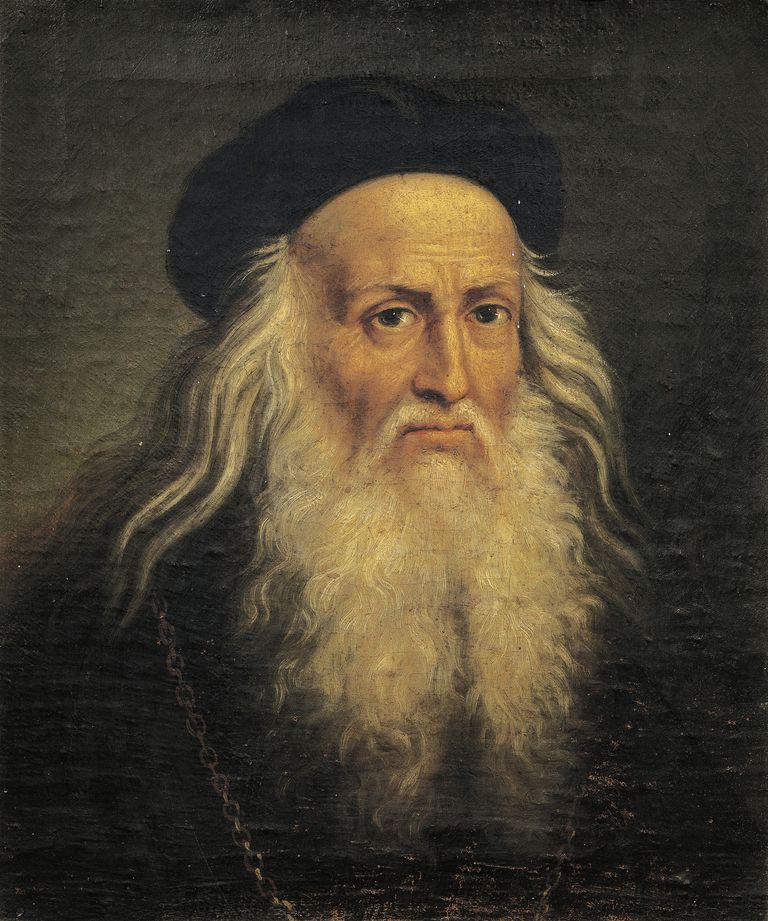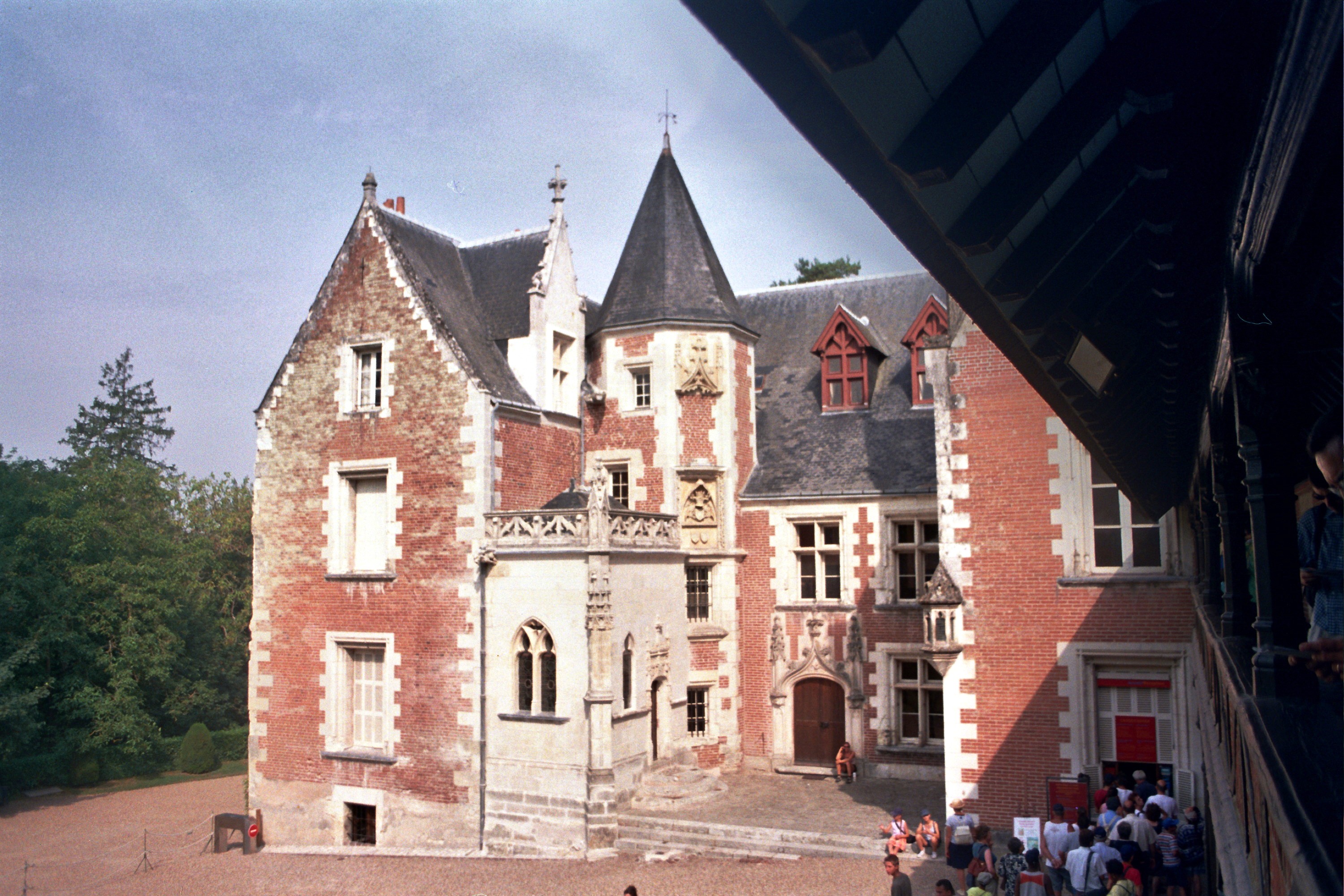

Queer Places:
Birthplace of Leonardo da Vinci, Via di Anchiano, 50059 Vinci FI
Château du Clos Lucé, 2 Rue du Clos Lucé, 37400 Amboise, Francia
St Hubert, 15 Rue de la Concorde, 37400 Amboise, Francia
 Leonardo di ser Piero da Vinci (15 April 1452 – 2 May 1519), more commonly Leonardo da Vinci or simply
Leonardo, was an
Italian
Renaissance polymath
whose areas of interest included
invention,
painting,
sculpting,
architecture,
science,
music,
mathematics,
engineering,
literature,
anatomy,
geology,
astronomy,
botany,
writing,
history,
and
cartography. He has been variously called the father of
palaeontology,
ichnology,
and architecture, and is widely considered one of the greatest painters of all
time. Sometimes credited with the inventions of the
parachute,
helicopter and
tank,[1][2][3]
he epitomised the
Renaissance humanist ideal.
Leonardo di ser Piero da Vinci (15 April 1452 – 2 May 1519), more commonly Leonardo da Vinci or simply
Leonardo, was an
Italian
Renaissance polymath
whose areas of interest included
invention,
painting,
sculpting,
architecture,
science,
music,
mathematics,
engineering,
literature,
anatomy,
geology,
astronomy,
botany,
writing,
history,
and
cartography. He has been variously called the father of
palaeontology,
ichnology,
and architecture, and is widely considered one of the greatest painters of all
time. Sometimes credited with the inventions of the
parachute,
helicopter and
tank,[1][2][3]
he epitomised the
Renaissance humanist ideal.
Many historians and scholars regard Leonardo as the prime exemplar of the "Universal Genius" or "Renaissance Man", an individual of "unquenchable curiosity" and "feverishly inventive imagination",[4] and he is widely considered one of the most diversely talented individuals ever to have lived.[5] According to art historian Helen Gardner, the scope and depth of his interests were without precedent in recorded history, and "his mind and personality seem to us superhuman, while the man himself mysterious and remote".[4] Marco Rosci notes that while there is much speculation regarding his life and personality, his view of the world was logical rather than mysterious, and that the empirical methods he employed were unorthodox for his time.[6]
Born out of wedlock to a notary, Piero da Vinci, and a peasant woman, Caterina, in Vinci in the region of Florence, Leonardo was educated in the studio of the renowned Florentine painter Andrea del Verrocchio. Much of his earlier working life was spent in the service of Ludovico il Moro in Milan. He later worked in Rome, Bologna and Venice, and he spent his last years in France at the home awarded to him by Francis I of France.

Château du Clos Lucé, 2 Rue du Clos Lucé, 37400 Amboise, Francia
Leonardo was, and is, renowned primarily as a painter. Among his works, the Mona Lisa is the most famous and most parodied portrait[7] and The Last Supper the most reproduced religious painting of all time.[4] Leonardo's drawing of the Vitruvian Man is also regarded as a cultural icon,[8] being reproduced on items as varied as the euro coin, textbooks, and T-shirts.
A painting by Leonardo, Salvator Mundi, sold for a world record $450.3 million at a Christie's auction in New York, 15 November 2017, the highest price ever paid for a work of art.[9] Perhaps fifteen of his paintings have survived.[nb 1] Nevertheless, these few works, together with his notebooks, which contain drawings, scientific diagrams, and his thoughts on the nature of painting, compose a contribution to later generations of artists rivalled only by that of his contemporary, Michelangelo.
Leonardo is revered for his technological ingenuity. He conceptualised flying machines, a type of armoured fighting vehicle, concentrated solar power, an adding machine,[10] and the double hull. Relatively few of his designs were constructed or even feasible during his lifetime, as the modern scientific approaches to metallurgy and engineering were only in their infancy during the Renaissance. Some of his smaller inventions, however, such as an automated bobbin winder and a machine for testing the tensile strength of wire, entered the world of manufacturing unheralded. A number of Leonardo's most practical inventions are nowadays displayed as working models at the Museum of Vinci. He made substantial discoveries in anatomy, civil engineering, geology, optics, and hydrodynamics, but he did not publish his findings and they had no direct influence on later science.[11]
Within Leonardo's lifetime, his extraordinary powers of invention, his "outstanding physical beauty", "infinite grace", "great strength and generosity", "regal spirit and tremendous breadth of mind", as described by Vasari,[64] as well as all other aspects of his life, attracted the curiosity of others. One such aspect was his respect for life, evidenced by his vegetarianism and his habit, according to Vasari, of purchasing caged birds and releasing them.[65][66]
It has been claimed since the 16th century that these relationships were of a sexual or erotic nature. Court records of 1476, when he was aged twenty-four, show that Leonardo and three other young men were charged with sodomy in an incident involving a well-known male prostitute, Jacopo Saltarelli. The charges were dismissed for lack of evidence, and there is speculation that since one of the accused, Lionardo de Tornabuoni, was related to Lorenzo de' Medici, the family exerted its influence to secure the dismissal.[70] Since that date much has been written about his presumed homosexuality and its role in his art, particularly in the androgyny and eroticism manifested in John the Baptist and Bacchus and more explicitly in a number of erotic drawings.[71]
Leonardo had many friends who are now renowned either in their fields or for their historical significance. They included the mathematician Luca Pacioli,[67] with whom he collaborated on the book De divina proportione in the 1490s. Leonardo appears to have had no close relationships with women except for his friendship with Cecilia Gallerani and the two Este sisters, Beatrice and Isabella.[68] While on a journey that took him through Mantua, he drew a portrait of Isabella that appears to have been used to create a painted portrait, now lost.[15]
Beyond friendship, Leonardo kept his private life secret. His sexuality has been the subject of satire, analysis, and speculation. This trend began in the mid-16th century and was revived in the 19th and 20th centuries, most notably by Sigmund Freud.[69] Leonardo's most intimate relationships were perhaps with his pupils Salai and Francesco Melzi. Melzi, writing to inform Leonardo's brothers of his death, described Leonardo's feelings for his pupils as both loving and passionate. Loyal to the end, Leonardo left Salai, a fat and coarsened grown-up, a bequest in his will and arranged a dowry for his sister. Salai was not loyal to Leonard and left the master before the end. His place was taken by a youth of good family and breeding, Francesco Melzi, who accompanied Leonardo to France. Francis I, a great patron of the arts (and also of women - he died of syphilis), was anxious to recruit the prestige of the "divine Leonardo", now famous all over Europe, to his nothern kingdom. The delicious little Gothic chateau of Cloux near Amboise, moated and turreted, was placed at his disposal, where he was assisted and regarded like the sovereign he was. When he died, the faithful Melzi inherited the incomparable mass of papers, thousands of sheets of notes, hundreds of drawings, models, figurines that he left behind. Francesco Melzi lived right up to 1570, within a couple of years of the Massacre of St Batholomew. The precious evidences of Leonardo's genius remained locked away in an attic in Milan, until collectors and hunters got on the track and the collection began to be dispersed.
My published books: